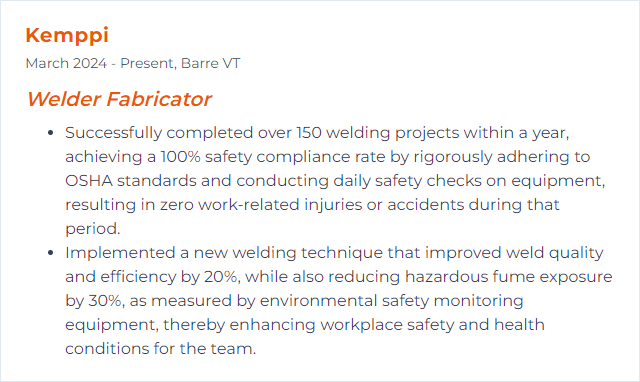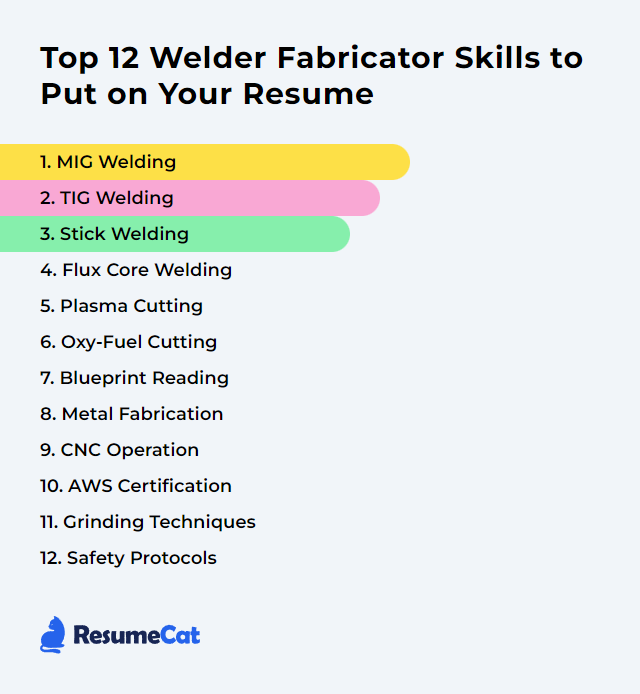Top 12 Welder Fabricator Skills to Put on Your Resume
In the competitive field of welding and fabrication, showcasing a robust set of skills on your resume can sharpen your edge and open doors. A clear, confident skills list signals proficiency, versatility, and readiness to handle the gritty, real-world challenges that come with the trade.
Welder Fabricator Skills
- MIG Welding
- TIG Welding
- Stick Welding
- Flux Core Welding
- Plasma Cutting
- Oxy-Fuel Cutting
- Blueprint Reading
- Metal Fabrication
- CNC Operation
- AWS Certification
- Grinding Techniques
- Safety Protocols
1. MIG Welding
MIG welding (commonly known as GMAW) uses a continuously fed wire and shielding gas to create clean, strong welds at speed. It’s approachable, adaptable, and well suited to production and job-shop work alike. Steel, stainless, aluminum—set it up right and it hums.
Why It's Important
MIG delivers fast, repeatable results with minimal post-weld cleanup, which translates to more parts out the door and consistent quality across varying material thicknesses.
How to Improve MIG Welding Skills
Dial in the fundamentals and your welds tighten up quickly:
Travel speed: Keep it steady. Too quick leaves undercut and lack of fusion; too slow piles up spatter and heat.
Torch angle and stick-out: Aim for 10–15 degrees push on thinner material; maintain a consistent stick-out (roughly 3/8 in) for stable arc behavior.
Gas and wire pairing: Use a C25 mix for mild steel, straight argon for aluminum, and wire diameter that matches thickness and joint design.
Prep and cleanliness: Bright metal wins. Remove coatings, mill scale, oil, and oxide layers.
Maintenance: Replace contact tips, liners, and nozzles when worn. Check drive rolls and tension. A smooth feed saves headaches.
Practice with intention: Run beads on scrap, change one variable at a time, and watch the puddle.
Small adjustments stack up. Your bead profile will tell the story—listen to it.
How to Display MIG Welding Skills on Your Resume

2. TIG Welding
TIG (GTAW) is the precision instrument of welding. A non-consumable tungsten, controlled heat, and finesse with filler produce clean, exact welds on thin stock and exotic alloys where appearance and integrity matter.
Why It's Important
When tolerances tighten and the finish is scrutinized, TIG brings fine control, low spatter, and excellent metallurgy—ideal for stainless, aluminum, titanium, and thin-gauge assemblies.
How to Improve TIG Welding Skills
Steady hands and smart setup do the heavy lifting:
Match tungsten and settings: Pick the right tungsten type and diameter, then set amperage, AC balance (for aluminum), and gas flow to suit the job.
Clean it like you mean it: Degrease base metal and filler. Use dedicated brushes for each alloy. Contamination ruins puddles.
Body position: Brace your hands, anchor your wrists, and keep arc length tight and consistent.
Foot pedal rhythm: Modulate heat to control puddle size and avoid burn-through on thin sections.
Filler selection: Match filler to base metal and service conditions. Check datasheets and procedures if in doubt.
Heat management: Preheat when required, and consider post-weld cooling or stress relief for susceptible alloys.
Patience and repetition pay off. TIG rewards calm, deliberate movement.
How to Display TIG Welding Skills on Your Resume
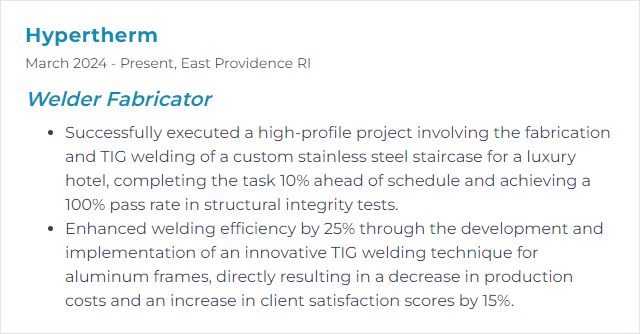
3. Stick Welding
Stick (SMAW) is rugged and forgiving. Flux-coated electrodes handle wind, dirt, and distance from the shop floor. Field repairs, structural work, heavy sections—this is the workhorse.
Why It's Important
It thrives outside and on less-than-perfect surfaces, needs minimal gear, and covers a wide range of materials and positions.
How to Improve Stick Welding Skills
Strip it back to basics and focus:
Electrode choice: Select rods for the material and position (e.g., 6010 for root passes, 7018 for strength and low hydrogen).
Amperage: Set current by electrode diameter and joint design; fine-tune after a test bead.
Arc length: Keep it short—about the diameter of the rod core—to improve penetration and reduce spatter.
Angle and travel: Use a slight drag angle. Vertical up for thicker material and stronger fusion; vertical down for thin stock and speed where appropriate.
Surface prep: Remove rust, paint, and oil. Good roots start with clean edges.
Bead discipline: Consistent speed, weave patterns only when needed, and overlap passes correctly.
Keep rods dry, store low-hydrogen electrodes properly, and your results stay consistent.
How to Display Stick Welding Skills on Your Resume
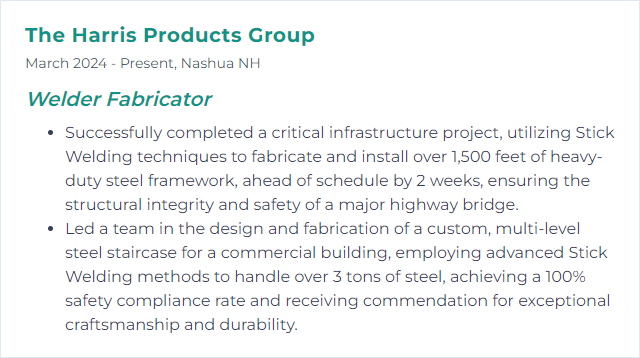
4. Flux Core Welding
Flux-cored arc welding (FCAW) runs a tubular wire filled with flux. It can be self-shielded or gas-shielded, hits high deposition rates, and powers through thicker materials—even when the wind kicks up.
Why It's Important
It’s fast, strong, and well suited to structural work, outdoors or in. Less sensitivity to conditions, more productivity on heavy sections.
How to Improve Flux Core Welding Skills
Set up right, move right, and keep it clean:
Prep: Clean mill scale, rust, and coatings. Good contact is everything.
Parameters: Match voltage, wire feed speed, and inductance to wire type and thickness. Start with manufacturer charts and tune by bead appearance.
Torch work: Hold 10–15 degrees drag, maintain steady stick-out (typically 3/4 in for FCAW), and keep travel smooth.
Wire selection: Pick the proper classification (e.g., E71T-11 for versatility, E71T-1 for gas-shielded applications).
Practice passes: Run stringers before weaving. Add weave only when procedure allows or joint demands it.
Safety: Proper PPE, ventilation, and slag management—always.
Watch slag behavior and ripple pattern; they’ll point you toward better settings.
How to Display Flux Core Welding Skills on Your Resume
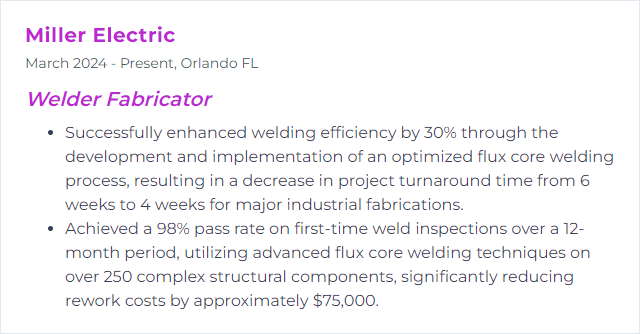
5. Plasma Cutting
Plasma cutting blasts an ionized gas stream through conductive metal, melting and ejecting material for quick, crisp cuts. From sheet work to plate, it’s a precision scalpel with speed.
Why It's Important
Clean kerfs, tight tolerances, less grinding after the cut—plasma boosts throughput and accuracy across varied metals and thicknesses.
How to Improve Plasma Cutting Skills
Quality hinges on setup and consistency:
Consumables: Use the right nozzle, electrode, and shield. Replace at the first sign of wear to avoid bevel and dross.
Torch height: Set and maintain proper standoff. Automated height control helps; templates and guides do, too.
Cutting speed: Tune travel speed to minimize dross and maintain a near-vertical edge. Watch the sparks—they should trail slightly.
Air quality: Dry, clean air is non-negotiable. Filters and dryers protect cut quality and consumable life.
Amperage and duty cycle: Match output to thickness. Don’t overpower thin stock; don’t starve thicker plate.
Guides and fixtures: Straightedges, circle guides, and templates make repeatable cuts painless.
Routine maintenance and disciplined technique keep cuts sharp and square.
How to Display Plasma Cutting Skills on Your Resume
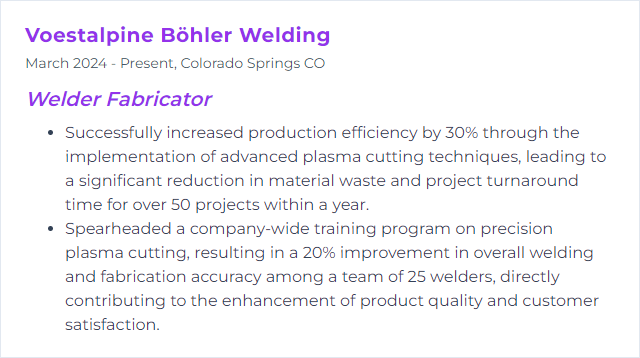
6. Oxy-Fuel Cutting
Oxy-fuel heats steel to its ignition temperature, then pure oxygen accelerates oxidation to slice through the metal. It shines on carbon steel plate and thick sections.
Why It's Important
For heavy work, it’s dependable and portable, with low equipment cost and straightforward setup—ideal for bevels, scrap cutting, and onsite fitting.
How to Improve Oxy-Fuel Cutting Skills
Technique and setup make or break the cut:
Nozzle selection: Size the tip to the plate thickness. Clean or replace tips when the flame distorts.
Gas pressures: Set oxygen and fuel to recommended ranges for stable preheat and clean kerfs.
Preheat and flame: Use a neutral flame. Preheat to a dull red before opening the oxygen jet.
Speed control: Move steadily. Too fast leaves uncut webs; too slow creates a wide, messy kerf and slag.
Surface prep: Remove heavy rust, paint, and coatings for consistent starts and smoother edges.
Safety: Backflow preventers, leak checks, good ventilation, and fire watch on combustible surfaces.
Note: Not suitable for aluminum or stainless due to oxide behavior—use plasma or mechanical methods instead.
How to Display Oxy-Fuel Cutting Skills on Your Resume
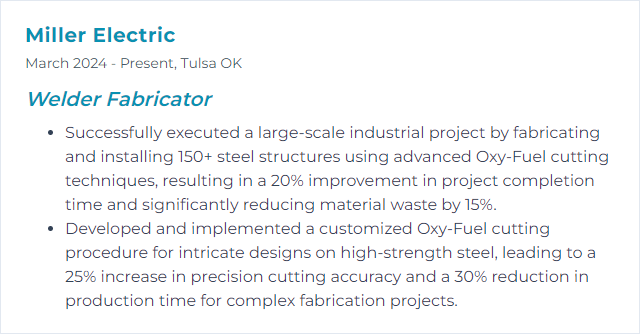
7. Blueprint Reading
Blueprint reading means decoding the language of drawings: views, dimensions, tolerances, welding symbols, materials, finishes, and notes that steer the build from concept to finished part.
Why It's Important
It’s the difference between guesswork and precision. Accurate interpretation ensures parts fit, assemblies align, and welds meet specification the first time.
How to Improve Blueprint Reading Skills
Train your eyes and habits:
Welding symbols: Study symbol structure, tail notes, contour, finish, and reference lines until they’re second nature.
Dimensions and GD&T: Understand linear dimensions, datums, and feature control frames so you can hit the required tolerance stack.
Views and sections: Practice reading orthographic, isometric, section, and detail views to see the part in 3D.
Materials and processes: Learn common alloy callouts, heat treatments, and finish notes that affect welding approach.
Reps and real parts: Study actual prints and compare to finished components. Books and shop exercises accelerate comprehension.
Take notes, sketch features, and verify assumptions before cutting or welding. Clarity saves rework.
How to Display Blueprint Reading Skills on Your Resume
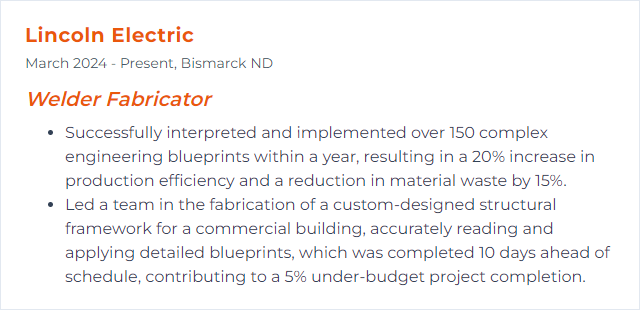
8. Metal Fabrication
Fabrication pulls together cutting, forming, fit-up, welding, and finishing to turn raw stock into parts and structures. It’s orchestration—process flow, fixtures, and inspection keeping time.
Why It's Important
From brackets to bridges, fabrication is the backbone of industrial work. Mastery brings repeatability, speed, and safe, reliable assemblies across sectors.
How to Improve Metal Fabrication Skills
Sharpen both craft and systems:
Process planning: Map steps from print to shipment. Reduce handling and wait time. Batch logically.
Fixturing and jigs: Build simple, robust fixtures to lock in alignment and reduce distortion.
Quality control: Use checklists, in-process inspections, and documented WPS/PQRs. Consider standards like ISO 3834 where applicable.
Distortion control: Sequence welds, balance heat, and clamp smartly. Back-step and skip weld when needed.
Continuous improvement: Track scrap, rework, and cycle time. Tweak the workflow with lean principles.
Good shops feel smooth. Everything has a place, and parts move forward without friction.
How to Display Metal Fabrication Skills on Your Resume

9. CNC Operation
CNC operation blends programming and machine control to cut, drill, mill, or profile parts with high repeatability. In a fab setting, that often means precision prep for welded assemblies.
Why It's Important
Accurate parts fit better, weld faster, and require less post-processing. CNC boosts throughput and consistency.
How to Improve CNC Operation Skills
Refine the digital and the physical:
Programming fundamentals: Clean G-code, efficient toolpaths, and smart lead-ins reduce time and improve edge quality.
Fixturing: Rigid, repeatable setups cut vibration and scrap. Use datums consistently.
Tooling: Choose the right cutters and consumables. Track wear and replace before tolerance drifts.
Machine care: Preventive maintenance, lubrication, and alignment checks keep accuracy tight.
Software: Keep CAM posts current and verify with simulation to avoid crashes and gouges.
Safety and training: Lockout procedures, guards, and ongoing upskilling for anyone at the controls.
Measure twice, program once, verify always.
How to Display CNC Operation Skills on Your Resume
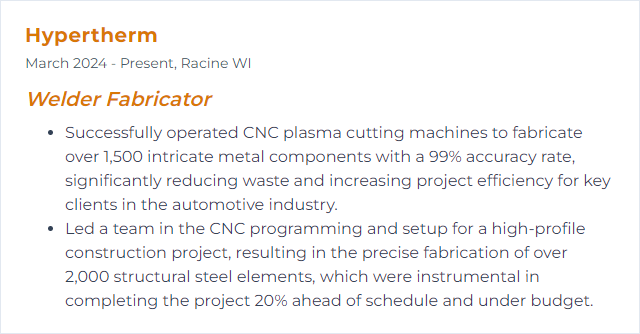
10. AWS Certification
AWS certification (American Welding Society) validates welding skill and code knowledge through standardized testing. Employers recognize it as proof you can meet procedure, quality, and safety expectations.
Why It's Important
It elevates credibility, opens doors to higher-spec work, and often ties directly to project and code requirements. Better jobs, better rates, clearer career paths.
How to Improve AWS Certification Skills
Build toward the credential and keep it current:
Pick the right track: Choose certifications aligned to your work (e.g., plate, pipe, positions, processes; or inspector tracks like CWI).
Train to a WPS: Practice with the exact joint prep, process, and parameters you’ll test on.
Theory matters: Study code fundamentals, discontinuities, metallurgy basics, and inspection criteria.
Hands-on reps: Run test joints under timed conditions. Cut and bend your practice coupons to validate fusion and soundness.
Stay current: Track renewal and continuity requirements, document your welds, and log hours.
Document everything. When audits come, records talk.
How to Display AWS Certification Skills on Your Resume
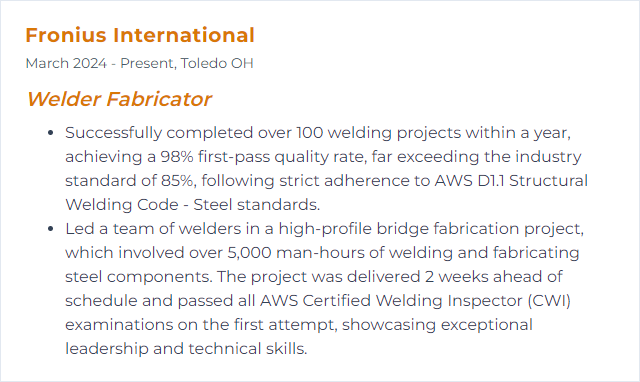
11. Grinding Techniques
Grinding shapes, blends, and finishes metal. From bevel prep to weld cleanup, the right abrasive and touch transform rough into ready.
Why It's Important
Good grinding improves fit-up, reduces defects, and polishes the final look—without overheating, gouging, or wasting time.
How to Improve Grinding Techniques Skills
Let the abrasive do the work, but set it up for success:
PPE and posture: Eye, ear, hand, and respiratory protection. Brace yourself to control angle and pressure.
Right tool, right media: Match wheel, flap disc, or belt to the job and material. Coarse for removal, fine for finish.
Angle and contact: Hold 15–30 degrees for most operations. Keep contact area modest to avoid heat soak.
Pressure and speed: Moderate, consistent pressure at the correct RPM prevents glazing and burns.
Maintenance: Inspect guards, flanges, and cords. Replace worn discs before they chatter or shed.
Inspect as you go: Check flatness, edge quality, and bevel size. Don’t grind past the goal.
Sparks tell tales—color, density, and direction hint at technique and pressure.
How to Display Grinding Techniques Skills on Your Resume

12. Safety Protocols
Safety protocols are the guardrails for welding and fabrication: PPE, ventilation, equipment checks, safe handling of cylinders and consumables, and procedures for fire, fumes, and electrical hazards.
Why It's Important
Hot metal, UV light, electricity, and airborne contaminants create real risk. Protocols tame that risk, protect people, and keep work moving without incident.
How to Improve Safety Protocols Skills
Embed safety into daily rhythms:
Training and refreshers: Regular instruction on PPE, lockout/tagout, hot work permits, and hazard recognition.
PPE fit and function: Proper lens shade, FR clothing, gloves, boots, and respiratory protection appropriate to the process and metal (watch hexavalent chromium with stainless).
Ventilation and fume control: Local extraction, clean air supply, and air monitoring where needed.
Equipment inspections: Cables, grounds, regulators, torches, and guards—inspect, document, and service on schedule.
Housekeeping and layout: Clear walkways, controlled spark zones, tidy leads and hoses to prevent trips and fires.
Emergency readiness: Extinguishers, first aid, eyewash stations, and practiced response plans.
Culture matters. When everyone owns safety, incidents drop and confidence rises.
How to Display Safety Protocols Skills on Your Resume
